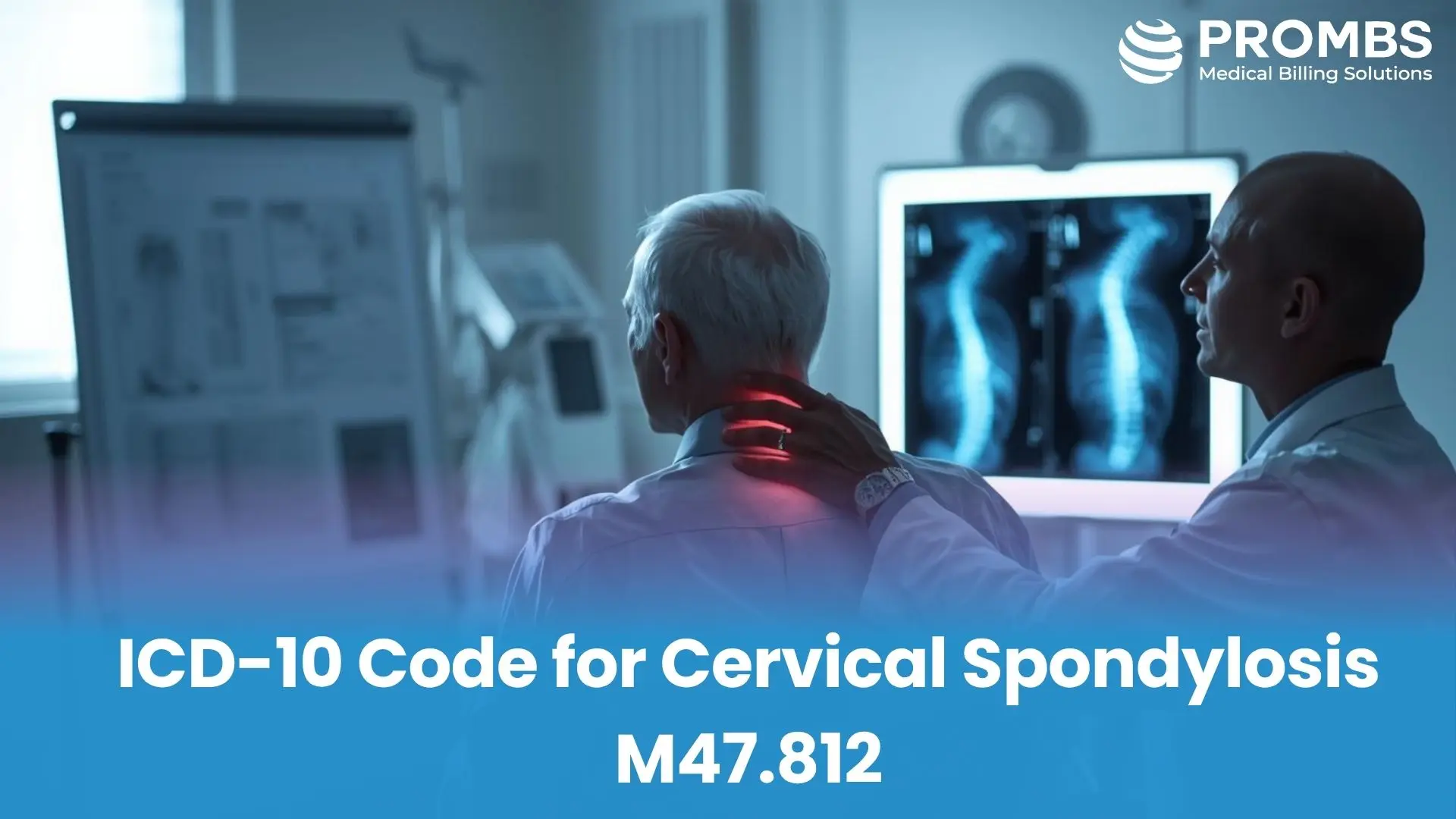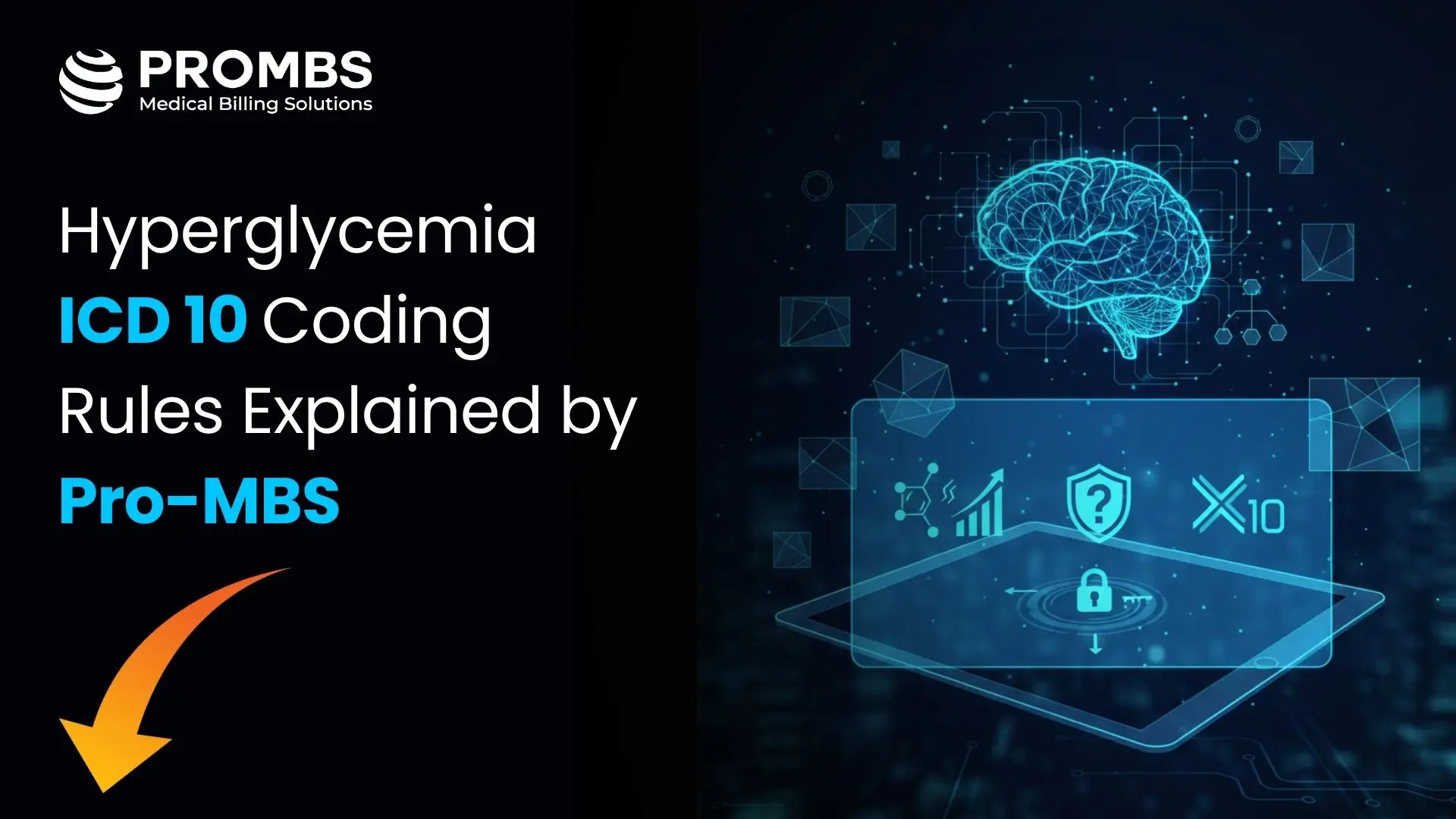Cervical spondylosis is not just a clinical condition but also a recurring billing challenge. Research published in StatPearls on Cervical Spondylosis confirms that over 85% of adults above 60 years demonstrate some form of cervical degeneration. In practice, this means coders encounter the icd 10 code for cervical spondylosis daily across multiple specialties, from neurology to orthopedic surgery.
The Centers for Medicare & Medicaid Services (CMS) emphasize that coding precision is vital because musculoskeletal disorders drive a significant proportion of Medicare expenditures. Errors in assigning the icd 10 code for cervical spondylosis can create ripple effects, leading to denials, compliance investigations, or improper payments.
What Is Cervical Spondylosis and What Are Its Symptoms?
Cervical spondylosis refers to the age-related degeneration of the cervical spine including the intervertebral discs, vertebral bodies, ligaments, and facet joints. Patients may present with stiffness, chronic pain, or neurological symptoms. As the Cleveland Clinic explains, when the spinal cord is compressed, cervical myelopathy can develop, leading to gait disturbance, weakness, or bladder dysfunction.
Symptoms billers should watch for in documentation includes neck pain and stiffness, Radicular pain radiating to the shoulder and arm, Tingling, numbness, or weakness in extremities, Headaches originating from cervical structures and Myelopathic signs such as balance issues or fine motor loss. For coders, the presence or absence of neurological deficits determines whether M47.812, M47.22, or M47.12 is appropriate.
Did You Know? A PMC study on cervical spondylosis prevalence found that more than 85% of people over 60 show degenerative cervical changes. For coders, this means M47-series diagnoses appear constantly in Medicare claims, making them a prime target for payer scrutiny.
What Is the ICD-10 Code for Cervical Spondylosis and What Does It Mean?
| ICD-10 Code | Clinical Meaning | Documentation Needed | CPT Examples Typically Paired |
|---|---|---|---|
| M47.812 | Represents cervical spondylosis without myelopathy or radiculopathy, meaning age-related degeneration or arthritis of the neck without neurological involvement. The CMS ICD-10-CM index lists this as the baseline cervical degeneration code. | Provider note describing neck stiffness or pain, and imaging reports confirming cervical degeneration, but explicitly stating no radiculopathy or myelopathy. As emphasized by the AAPC’s medical necessity guide , this prevents unnecessary denials. | 72040 (cervical X-ray, 2–3 views) and 97110 (therapeutic exercise for conservative care), both supported in AMA CPT coding resources. |
| M47.22 | Indicates cervical spondylosis with radiculopathy, where nerve roots are compressed, producing pain, tingling, or weakness. The AAPC ICD-10 code set defines this specifically for radiculopathy. | Documentation must describe dermatomal pain, sensory/motor deficits, or reflex changes, with imaging correlating to foraminal stenosis. According to the Cleveland Clinic, these findings are essential for accurate diagnosis and billing. | 72141 (MRI cervical spine without contrast) and 62321 (epidural steroid injection), which the AMA CPT guidelines note are tied to radiculopathy when medically necessary. |
| M47.12 | Refers to cervical spondylosis with myelopathy, a serious complication where the spinal cord is compressed. ICD10Data clarifies its use when neurological deficits are cord-related rather than root-related. | Provider note must include findings such as gait disturbance, loss of dexterity, or bladder/bowel dysfunction, backed by MRI evidence of cord compression. As the Cleveland Clinic emphasizes, this documentation is critical because myelopathy has long-term disability risks. | 22845 (anterior cervical instrumentation) and 63045 (cervical decompression surgery), which AMA CPT resources list for surgical management of spinal cord compression. |
Did You Know? According to the Cleveland Clinic, cervical myelopathy, represented in coding as M47.12, is one of the most serious complications of spondylosis because spinal cord compression can cause permanent disability if left untreated. From a billing standpoint, this means that documenting and coding myelopathy accurately not only ensures proper reimbursement but also safeguards providers in the event of a medical audit.
What Is Cervical Spondylosis and Why Does It Matter in Medical Billing?
Cervical spondylosis refers to degenerative changes in the cervical spine, including disc degeneration, osteophyte formation, and facet joint arthritis. It’s extremely common after age 50, with studies showing that more than 85% of people over 60 have some form of cervical degeneration (NIH).
For billing and coding, cervical spondylosis matters because it frequently requires imaging (X-ray, MRI, CT). Patients often undergo multiple treatments (physical therapy, injections, or surgery).Coders must pair ICD-10 diagnostic codes with the correct CPT procedures to avoid mismatched claim denials. Payers demand clear documentation that connects the diagnosis to the service provided.
Did You Know? According to the Office of Inspector General (OIG), musculoskeletal-related improper payments cost Medicare billions annually, largely due to incomplete documentation and miscoding of conditions like spinal degeneration.
Which ICD-10 Chapter Includes Cervical Spondylosis?
Cervical spondylosis sits in Chapter XIII: Diseases of the musculoskeletal system and connective tissue (M00–M99), and this placement matters because chapter- and block-level notes control how you differentiate spondylosis from other spinal conditions. You can see how M47 (Spondylosis) is organized inside Chapter XIII in the current ICD-10-CM Official Guidelines published by CMS, which explain chapter scope, inclusion/exclusion notes, and FY-effective dates directly inside the guideline text at the time of publication (for example, the FY 2025 guidelines on the CMS site). Within that structure, the icd 10 code for cervical spondylosis belongs specifically to M47, which is distinct from disc disorders such as M50 (Cervical disc disorders), a distinction you can verify by comparing the M47 block text with standard code references like ICD10Data’s M50 overview, where disc herniation and internal disc disruption are organized under a different block.
| Level | Where It Sits | What It Covers | How It Guides Coders |
|---|---|---|---|
| Chapter XIII (M00–M99) | Musculoskeletal diseases. The CMS ICD-10 page explains this chapter includes arthritis, deformities, and degeneration. | Broad scope: arthritis, joint disorders, and spinal conditions. | Coders must first confirm that the diagnosis is musculoskeletal before moving to block/category. |
| Block M45–M49 (Spondylopathies) | Grouping of spine-related diseases such as ankylosing spondylitis, inflammatory spondylopathies, and degenerative spondylosis. ICD10Data’s block index confirms this. | Includes spondylosis but excludes disc disorders (those are in M50). | Coders should check Excludes notes at the block level to avoid misclassifying disc problems as spondylosis. |
| Category M47 (Spondylosis) | The specific category containing cervical spondylosis subcodes (M47.812, M47.22, M47.12). AAPC’s ICD-10 coding guide details these. | Distinguishes uncomplicated cases from those with radiculopathy or myelopathy. | Coders must capture neurological status clearly, otherwise, claims may be denied for lack of specificity. |
Which CPT Codes Pair with the ICD-10 Code for Cervical Spondylosis?
The icd 10 code for cervical spondylosis must always be paired with an appropriate CPT code to demonstrate medical necessity. While ICD-10 codes explain why a patient is receiving care, CPT codes explain what service was provided. Payers review both sides of this equation to determine whether a claim should be reimbursed. If the CPT procedure and ICD-10 diagnosis don’t align, denials are almost guaranteed.
The American Medical Association (AMA) underscores this in its CPT guidance: accurate linkage between ICD-10 and CPT protects providers from unnecessary rejections and audit risk. For example, billing an MRI of the cervical spine (CPT 72141) without documenting neurological deficits in the chart and coding M47.22 (cervical spondylosis with radiculopathy) or M47.12 (with myelopathy) would be seen as medically unsupported. Equally, conservative treatments such as physical therapy must match uncomplicated spondylosis codes like M47.812, whereas interventional procedures such as epidural injections require documentation of radiculopathy to justify M47.22.
| Service Type | Example CPT Code | ICD-10 Linkage | How They Connect in Billing |
|---|---|---|---|
| Radiology | 72040 (Cervical spine X-ray, 2–3 views) is used to evaluate spinal degeneration. According to the AMA CPT overview, this test is justified when documenting M47.812 (degeneration without neuro involvement). | M47.812 | Demonstrates baseline degenerative changes without neurological signs, supporting conservative management. |
| MRI | 72141 (MRI cervical spine without contrast) is typically ordered when radiculopathy or myelopathy is suspected. The AMA CPT code set explains that such imaging is necessary when paired with M47.22 or M47.12. | M47.22 or M47.12 | Shows nerve root or spinal cord compression correlating with neurological findings, validating advanced imaging. |
| Physical Therapy | 97110 (Therapeutic exercises), described in CPT guidelines, is billed for conservative care when symptoms are mechanical and uncomplicated. | M47.812 | Provides evidence that conservative therapy was attempted before escalating to injections or surgery. |
| Injections | 62321 (Cervical/thoracic epidural injection) is coded when radicular pain is documented. AMA CPT resources note that it must align with a radiculopathy diagnosis. | M47.22 | Links an interventional pain procedure to radicular symptoms, demonstrating medical necessity. |
| Surgical Procedures | 22845 (Anterior cervical instrumentation) or 63045 (Cervical decompression surgery), described by the AMA CPT index, are major surgeries for myelopathy. | M47.12 | Justified only when provider documentation and imaging confirm spinal cord compression and myelopathic deficits. |
Did You Know? The Cleveland Clinic notes that cervical myelopathy often requires surgical intervention because untreated cord compression can cause permanent disability. In billing terms, this means procedures like CPT 63045 (decompression) or 22845 (instrumentation) must only be paired with M47.12 (cervical spondylosis with myelopathy), using a less specific ICD-10 code could result in claim denials or audits.
What Treatments Are Associated with Cervical Spondylosis?
Treatment strategies guide CPT–ICD linkage. The Cleveland Clinic outlines conservative measures such as medications, physical therapy, and activity modification as first-line interventions. Interventional pain management, such as epidural steroid injections, may follow. Surgery, including cervical decompression and fusion, is reserved for cases with intractable radiculopathy or progressive myelopathy. Coders should remember that payers often require documentation of failed conservative care before approving interventional or surgical claims.
How Should Documentation Be Structured to Avoid Denials?
Even when the icd 10 code for cervical spondylosis is correct, claims can still be denied if the documentation is vague, incomplete, or inconsistent with payer expectations. According to the AAPC’s medical necessity guidance, payers look beyond the diagnosis code, they review whether the provider’s note clearly supports why the service was needed and how the diagnosis was determined.
For cervical spondylosis, denial risks often come from Lack of specificity (e.g., coding M47.22 without describing radiculopathy in the exam), Missing imaging correlation (e.g., MRI shows cord compression but the provider note doesn’t mention myelopathic findings), No documentation of conservative therapy (required before injections or surgery in many payer policies) and Contradictory records (the provider says “no neurological deficits” but the coder selects M47.12).
| Documentation Element | Poor Example | Strong Example | Why It Matters |
|---|---|---|---|
| History & Symptoms | “Neck pain, arthritis.” | “Patient reports chronic neck stiffness, radiating pain into the right arm with numbness in the thumb.” | Specific symptom descriptions support M47.22 for radiculopathy rather than a nonspecific code. |
| Physical Exam | “Exam normal.” | “Positive Spurling’s sign, diminished C6 reflex, sensory deficit in C6 dermatome.” | Aligns with radiculopathy, justifying the CPT code for an epidural injection when paired with M47.22. |
| Imaging Findings | “MRI done.” | “MRI (dated 03/15/25) shows C5–C6 foraminal stenosis compressing the right C6 root.” | Imaging must correlate with symptoms and ICD-10 code, supporting medical necessity as outlined by CMS ICD-10 guidelines. |
| Treatment Pathway | “Injection given.” | “Conservative care attempted with PT x6 weeks, epidural injection planned for persistent radicular pain.” | Demonstrates payer-required escalation of care, linking M47.22 to CPT 62321. |
| Neurological Status | “Cervical spondylosis.” | “Findings consistent with cervical myelopathy: gait disturbance, hyperreflexia, MRI cord compression → M47.12 assigned.” | Clear neurological deficits are mandatory to justify major surgical CPTs like 63045. |
Did You Know? The OIG has identified musculoskeletal coding errors as a top source of improper Medicare payments. In particular, spondylosis claims with unspecified codes are flagged at higher rates than other conditions.
How Can Technology Help Prevent Denials for Cervical Spondylosis?
The Healthcare Financial Management Association (HFMA) notes that predictive analytics can cut denial rates by over 20%. EHRs increasingly prompt coders with compliance checks, asking whether a diagnosis like cervical spondylosis should be coded with or without radiculopathy before claim submission.By using AI-driven claim scrubbers, providers can proactively avoid mismatched ICD-10–CPT pairings that otherwise result in payer rejections.
Why Should Providers Partner with PROMBS for Cervical Spondylosis Billing?
At Pro Medical Billing Solutions (PROMBS), we help healthcare providers and billing companies master ICD-10 coding precision. Our expertise includes correctly assigning M47.812, M47.22, and M47.12 based on documentation, linking ICD-10 codes with the right CPT procedures for radiology, PT, injections, and surgery, denial management strategies built around compliance audits and alignment with CMS guidelines and OIG standards. Our detailed CMS-1500 Claim Form Guide (2025) explains how Dx pointers, POS codes, and modifiers must align to ensure first-pass claim acceptance.
Cervical spondylosis is common, but billing it correctly requires precision. The icd 10 code for cervical spondylosis falls within the M47 category and must reflect the presence or absence of radiculopathy or myelopathy. Coders should align documentation with clinical findings, choose accurate CPT pairings, and ensure compliance with CMS and payer policies. Partnering with PROMBS ensures providers achieve accurate reimbursement, reduced denials, and audit-ready claims.



